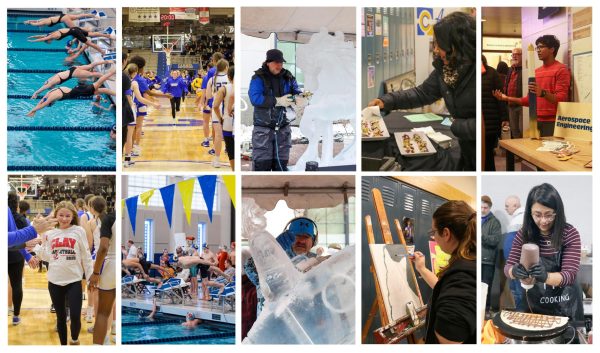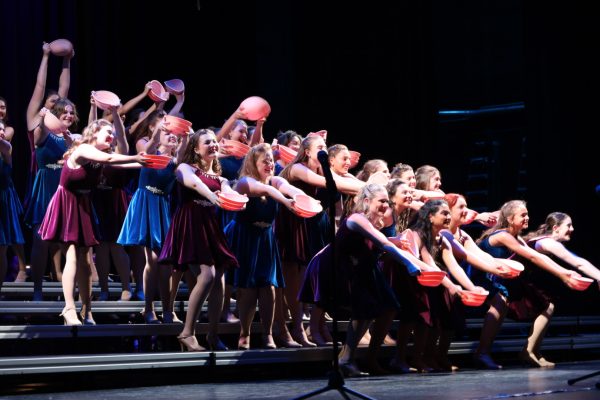Fowl Play at Hand: Students, school should be aware of chicken farming methods
More in Online Only:
According to the USDA, chicken is the most popular meat in the U.S. by consumption; per capita consumption in 2006 was 87 pounds. Chicken is the center of some of America’s most popular dishes, from General Tso’s chicken to Southern-style fried chicken, and eggs as another classic food staple of breakfast, lunch and dinner.
As a lover of both chickens and chicken-based foods, I was horrified to learn the inhumane nature of factory farming when the Environmental Action Club invited a speaker to talk about mass production farming. She described not only the animal welfare concerns, but also the environmental effects of forcing so many animals in a small area.
In order to “meat” the high demand for chicken and chicken products, factory farming is necessary to quickly churn out thousands of eggs and chicken for the market. Chickens are forced to grow quickly in crowded and dirty conditions, as this creates a serious animal welfare problem. According to The Guardian, chickens are kept in cages as small as a sheet as paper, have their beaks painfully removed after birth and grow as such rates that they experience health issues like heart failure. Furthermore, cages are rarely cleaned, forcing chickens to live among their waste, which can cause disease to spread.
Although I am not against growing chickens for consumption, I believe that the cruelty inflicted on chickens is simply inhumane. No one would wish such terrible conditions on cats and dogs, so why should chickens be any different? Chickens are just as intelligent and loving as these pets, and protecting cat and dog rights without protecting chicken rights is simply hypocritical.
The school makes a big statement with its food choices. With over 5,200 students this year, CHS’s cafeterias demand to purchase large amounts of chicken and egg products to feed its population is a given, as many items on the menu incorporate chicken; Chicken patty sandwiches, chicken smackers and chicken nuggets are just a few meals the school offers that contain poultry. Additionally, nutrition and culinary arts classes practice chicken and egg recipes. It can be difficult to find large quantities of chicken for low prices from companies other than big factory farmers. After looking at the facts, I believe the school should reduce the amount of chicken it uses or making a switch to an alternative vegetarian or substitute chicken option.
Students also place a crucial part in making more conscious efforts when buying chicken and eggs. They can limit their consumption of chicken or forgo it altogether. Vegetarian chicken is becoming increasingly accurate to the taste and texture of real chicken. Kroger carries Simple Truth meatless foods and Quorn meatless foods. If giving up chicken is not an option (and for me, it isn’t), the least one can do is to be aware of the origin of their chicken and eggs.
Package labeling for chicken products can be outright misleading and difficult to verify. “Free-range,” “pasture-raised,” and “cage-free” are labels that are not regulated by the USDA, and factories may still be raising their chicken in unsanitary and crowded conditions. One label to look for is the Animal Welfare Approved labeling from a nonprofit organization called A Greener World on the packaging. The Animal Welfare Institute has more progressive standards than the American Humane Association and Humane Farm Animals Care and is regarded as the only “highly meaningful” standard. If students want to purchase humanely-raised chicken, the Gordon Family Farm at Zionsville Farmers’ Market is a good place to get Certified Animal Welfare Approved products.
Overall, it is difficult to change the chicken industry’s farming practices alone, but altogether, through the power of dollars and human activism, consumers can make a difference in creating a change in chicken farming and maintaining accountability. Students at CHS can help affect change by becoming aware of what they buy.
Your donation will support the student journalists of Carmel High School - IN. Your contribution will allow us to purchase equipment and cover our annual website hosting costs.































![What happened to theater etiquette? [opinion]](https://hilite.org/wp-content/uploads/2025/04/Entertainment-Perspective-Cover-1200x471.jpg)














































![Review: “The Immortal Soul Salvage Yard:” A criminally underrated poetry collection [MUSE]](https://hilite.org/wp-content/uploads/2025/03/71cju6TvqmL._AC_UF10001000_QL80_.jpg)
![Review: "Dog Man" is Unapologetically Chaotic [MUSE]](https://hilite.org/wp-content/uploads/2025/03/dogman-1200x700.jpg)
![Review: "Ne Zha 2": The WeChat family reunion I didn’t know I needed [MUSE]](https://hilite.org/wp-content/uploads/2025/03/unnamed-4.png)
![Review in Print: Maripaz Villar brings a delightfully unique style to the world of WEBTOON [MUSE]](https://hilite.org/wp-content/uploads/2023/12/maripazcover-1200x960.jpg)
![Review: “The Sword of Kaigen” is a masterpiece [MUSE]](https://hilite.org/wp-content/uploads/2023/11/Screenshot-2023-11-26-201051.png)
![Review: Gateron Oil Kings, great linear switches, okay price [MUSE]](https://hilite.org/wp-content/uploads/2023/11/Screenshot-2023-11-26-200553.png)
![Review: “A Haunting in Venice” is a significant improvement from other Agatha Christie adaptations [MUSE]](https://hilite.org/wp-content/uploads/2023/11/e7ee2938a6d422669771bce6d8088521.jpg)
![Review: A Thanksgiving story from elementary school, still just as interesting [MUSE]](https://hilite.org/wp-content/uploads/2023/11/Screenshot-2023-11-26-195514-987x1200.png)
![Review: "When I Fly Towards You", cute, uplifting youth drama [MUSE]](https://hilite.org/wp-content/uploads/2023/09/When-I-Fly-Towards-You-Chinese-drama.png)
![Postcards from Muse: Hawaii Travel Diary [MUSE]](https://hilite.org/wp-content/uploads/2023/09/My-project-1-1200x1200.jpg)
![Review: "Ladybug & Cat Noir: The Movie," departure from original show [MUSE]](https://hilite.org/wp-content/uploads/2023/09/Ladybug__Cat_Noir_-_The_Movie_poster.jpg)
![Review in Print: "Hidden Love" is the cute, uplifting drama everyone needs [MUSE]](https://hilite.org/wp-content/uploads/2023/09/hiddenlovecover-e1693597208225-1030x1200.png)
![Review in Print: "Heartstopper" is the heartwarming queer romance we all need [MUSE]](https://hilite.org/wp-content/uploads/2023/08/museheartstoppercover-1200x654.png)







